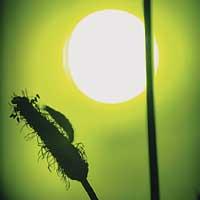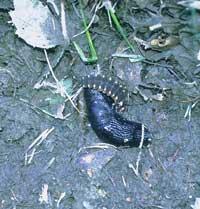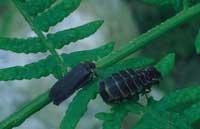The light… a dark future for fireflies
The truth is that from childhood I was surprised and fascinated the animal that lit that light the night. However, this feeling sharpened notably as a result of the event lived in Irati about five years ago. After spending the day on the mountain, in that warm sunset we began to prepare a dinner in an opening of the forest. Looking at the macaroni cooked that was boiling like hungry dogs, some bugs started to turn around our streetlights. The insects were left in the head and especially in the center of the co-pilot and occasionally some fell to the macaroni or calcined in the boilers of the butane cook. We were surprised and until we turned off all the lights did not leave us alone. What could be those bugs that had not been invited? That was a reader, they were fireflies!

Among the different systems of attraction of players, one of the most curious is the firefly, since these coleoptera use light for this task. The foolishness of the fireflies of that night of Irati can be understood like this: the males looked for their breeder and, in the middle of the forest, they mixed with the light of the females and came “to the fire”. However, apart from these confusions, light can be a good communication tool, since it can be done at long distances at a dizzying speed and without any muscle work.
Let's start with the taxonomic situation of these invertebrates. We have fireflies, hexagons or insects. Within them, they are classified in the order of the coleoptera and, specifically, in the family of lanpiriers. This family has around 1,700 species worldwide, and in Euskal Herria we only have one species, the common firefly (Lampyris noctiluca). The male and the female have a very different aspect. Males are like beetles, so to speak, and winged. They have a length of 10-12 mm and, like the typical coleoptera, their front wings (elitros), sclerified or hardened, and under them the fine southern membranes. Brown colors. The females, without wings, are very similar to the larvae. They have a length of 15-20 mm and are dark brown and smooth.
These curious insects inhabit grass fields, roadsides, fences, forests and scrublands and adults are found between June and September. The nocturnal ones, usually after darkening and, in most cases, we will find in the light of the females.

As for food, the larvae are hunters of molluscs that feed on snails and slugs. For hunting and consumption, sharp, sick-shaped masajillas are used which, when they bite the piece, introduce a dark fluid. This substance is not the secretion of the salivary glands, since it does not contain them. On the contrary, it seems that the fluid occurs in the acidic glands located in the proximities of the intestine, which causes the rupture and dissolution of the mollusk tissues. The larvae of the firefly, therefore, perform in large measure an external digestion and then proceeds to the sorption of the prepared food thanks to the fluid. Adults, for their part, eat nothing or almost nothing and their only function is reproduction.

Undoubtedly, the most characteristic feature of fireflies is that of “lighting” the light. The female firefly, in the last three segments of the abdomen, has thousands of photocytes that allow it to make a light without heat such as bioluminescence. The famous light occurs as a result of chemical reactions and, in particular, through reaction: the reduced substance, called luciferin, is activated by the catalyzing enzyme, luziferase, which reacts with oxygen producing light. It should be noted that there are many species of fireflies in the warm regions and that lighting of light is not enough to find a player. In these regions, each species has its own luminous signal so that different species are not mixed.
The female, therefore, from the ground, through some stretch of grass or some plant, performs in the abdomen a phosphorescence of green color towards the sky, in order to attract flying males. When the male finds the female they are paired and then the racket is produced. From the eggs are born larvae that resemble the female and once the metamorphosis is done they acquire the form of adults.

This unique animal, which lives in southern Europe, was common in most of the corners of Euskal Herria. How… was it? Is it not current today? Apparently, this animal is not today as abundant as it was before. According to some experts, in recent years he is suffering a slight decline, and the truth is that his hypothesis seems reasonable. As it happened to us in the forest of Irati, it seems that in many other places the male fireflies chase the night lights in the hope of the females. But the fireflies, instead of their favorite females, are found with the lights of streets, houses, cars, co-pilot, etc. Of course, to carry out this reproduction it is very difficult to find a couple and only in areas as wild as Irati will the fireflies multiply correctly.

Undoubtedly, this is a problem of difficult solution. In the last 100 years, both Euskal Herria and most other regions of the world have changed radically. As for the night, a few decades ago, when there was no artificial light, except some quinque, low fire or candle, the system of fireflies was perfect to find a couple. However, the development of technology in recent years has brought with it an increase in lighting and, by chance, we have realized that this can be harmful to some species. Keeping the populations of places where the nights are still dark, we hope not to miss all the fireflies! And to finish, reader, can any light of your house be useless at this time and why keep it so? If you turn it off, among other benefits, you can benefit a firefly looking for a couple. Surprising, right?
Species: Lampyris noctiluca Family: Lanpiramids Order: Coleoptera Class: hexagpods |





